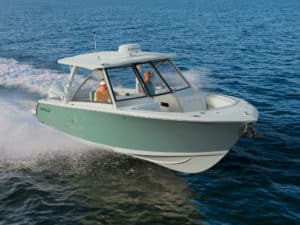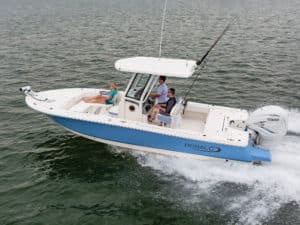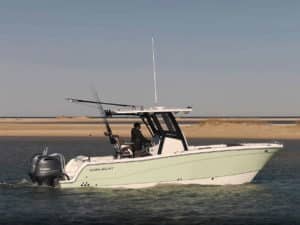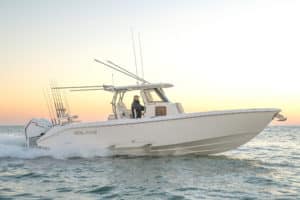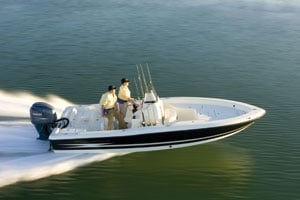
04hydrasports
We put the boat on a diet,” Hydra-Sports product manager Lee Anderson told me.
OK, I’m thinking, April Fool’s, right?
Then we walked down the dock, and I saw this “ample” bay boat. Its 8-foot-10-inch girth – er, beam – created such a broad bottom, it would have impressed Dr. Atkins. With such dimension, how had Hydra-Sports cut almost 1,000 pounds off the weight of its predecessor?
“We designed a Kevlar-based stringer system,” Anderson said. The system “was designed the first go-round to be suitable for a 27-footer. So it has been redesigned to fit its purpose.”
Performance
The 2300 Bay Bolt’s immediate purpose included taking myself and Sport Fishing publisher Glenn Hughes to a mangrove shoreline that looked “snooky.”
I motored slowly away from the dock at the Cay Club in Sarasota, Florida, and Hughes began plugging the banks. At idle, the boat seemed as stable as a picnic table. The broad beam allowed it to float quite shallow, drawing only 10 inches.
After a few uneventful casts, Hughes stowed the fishing gear – for the moment – and we continued toward open water in Sarasota Bay. A slight breeze caused minimal disturbance on the open water – not enough chop to challenge this lighter-but-substantial bay buster. So, we manufactured chop, courtesy of our photo boat. The Bay Bolt landed solidly, squarely and dryly.
I floored the throttle with the engine trimmed down but without using the tabs, which are an option on this boat. The 23 rose to plane in about four seconds. Goosing the Yamaha F250 to top speed and adjusting trim, we found 53.2 mph on the handheld GPS at 6,000 rpm, burning about 21.4 gph. Our 77-gallon fuel tank measured nearly full, and we had requisite safety gear and a few rods aboard.
Our boat came with an optional jack plate too, but in adjusting its height, we found no more inherent speed. Yamaha subsequently tested the boat a few days later and measured 55.3 mph at 6,000 rpm, burning 21.1 gph.
We liked a cruising speed of 35.8 mph at 4,000 rpm. At that pace, the burn was a very reasonable 9.6 gph. If you prefer a tad more leisurely ride, at 3,500 rpm, the boat tooled along at 30.3 mph and burned 7.2 gph.
In tight turns, the broad beam became only a slight impediment. The boat leaned fairly hard but bled off speed quickly and safely. The hull spun up efficiently with tabs down, punching us out of the hole.
Fishing
While I was focused on turns and trim, our designated angler pointed out some intriguing surface ripples farther out in the bay. Birds seemed to be paying close attention to the area.
If Hughes had brought live bait, he could have tried out the lighted 15-gallon pitch well at the aft edge of the casting deck to keep his bait frisky and ready for bow deployment. I consider this an especially useful feature and an obvious sign that Hydra-Sports does its fishing homework.
The 23’s forward casting deck offers a broad expanse of fiberglass for fishing or cast-netting. The starboard lockable storage compartment features 94 quarts of insulated space or room to store two rods. The insulated and lockable port box holds six rods. Another deep forward locker offers space to store a cast net in a bucket. Just aft of the platform, an in-deck box holds safety gear or a freshwater tank.
Instead of standard forward-console seating, the Bay Bolt comes with an aft center seat for passengers. However, Hydra-Sports offers optional forward seating in the form of a half-moon-shaped Frigid Rigid cooler with a cushion.
The center-console helm featured four vertical rod holders on each side, a compact windshield and handholds. Four more in-gunwale rod holders increased vertical storage capacity to 12 rods.
Gauges and switches stacked up on a fairly vertical console face, which helps cut glare. The aluminum wheel, featuring tilt-hydraulic steering, lined up fine for me, but a tad low for the 6-foot-plus Hughes.
Beneath the aft center seat, Hydra-Sports plumbed a 32-gallon baitwell with a 1,100-gallon-per-hour pump. Two three-drawer tackle bins flank the seat and are recessed into the aft casting deck.
Design and Construction
Besides trimming pounds from the 23’s foam-filled stringer grid by using lightweight Kevlar material, Hydra-Sports also widened the gunwales, increased the size of the casting decks fore and aft, added lockable rod storage, centered and enlarged the livewells and redesigned the transom seat, Anderson said. “We utilized the same running surface ? we couldn’t find a better running hull,” he said. “It’s the widest in its class.”
The renovated stringer system is integrated into the poured-ceramic transom and is Plexus- and fiberglass-bonded to the hull. The hull itself incorporates hand-laid woven roving, pre-cut biaxial fabric and Kevlar with vinylester resin.
As a final touch, Hydra-Sports accentuated the hull sheer for looks. The resulting design offers a clean, classic look reminiscent of typical offshore center consoles – only the sides are lower.
| LOA…..22 ft. 11 in. BEAM…..8 ft. 10 in. **HULL DRAFT…..10 in.** DEADRISE…..14 deg. **WEIGHT…..3,100 lb. (w/ F250 Yamaha)** FUEL…..77 gal. **MAX HP…..300 hp OB MSRP…..$ 49,845 (w/ F250 Yamaha)** | YAMAHA…..250 hp Four-stroke **TYPE…..60 deg. V-6 DISPL…..204.6 cid MAX RPM…..6,000 HP/LB RATIO…..0.42 FUEL SYSTEM…..EFI GEAR RATIO…..2:1 WEIGHT…..592 lb. ALT. OUTPUT…..45 amps MSRP…..$20,090** |
**Hydra-Sports / Sarasota, Florida / 800-603-BOAT / **www.hydra-sports.com

